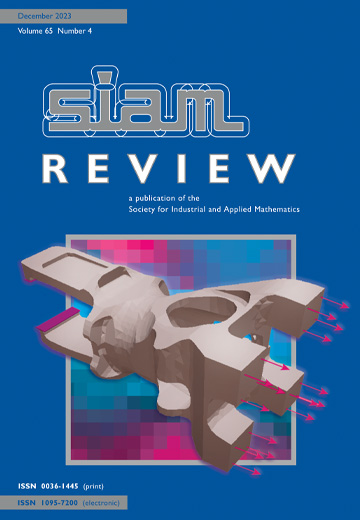亥姆霍兹边界元法是否受到污染影响?
IF 6.1
1区 数学
Q1 MATHEMATICS, APPLIED
引用次数: 5
摘要
SIAM评论,第65卷第3期,第806-828页,2023年8月。在$d$维中,精确近似以频率$\lesssim k$振荡的任意函数需要$\lessim$k^d$自由度。求解亥姆霍兹方程的数值方法(波数为$k$,维度为$d$)受到污染影响,如果为$k→∞$, 保持精度所需的总自由度的增长速度快于该自然阈值(即,对于基于域的公式,如有限元方法,快于$k^d$,对于基于边界的公式,例如边界元方法,慢于$k^{d-1}$)。众所周知,有限元方法(FEM)的$h$-版本(其中通过减小网格宽度$h$并保持多项式次数$p$固定来提高精度)受到污染影响,过去30年的研究几乎完全了解了自由度的数量必须以多快的速度随$k$增长才能保持准确性(以及这如何取决于$p$和散射体的性质)。与$h$-FEM相比,至少在经验上,$h$-版本的边界元方法(BEM)没有受到污染影响(回想一下,在边界元方法中,散射问题被重新表述为散射体边界上的积分方程,然后使用有限元型近似空间对该积分方程进行数值求解)。然而,目前文献中关于$h$-BEM的自由度数量必须以多快的速度随$k$增长才能保持准确性的最佳结果未能证明这一点。在本文中,我们证明了用于求解亥姆霍兹-外狄利克雷问题的标准第二类边界积分方程的Galerkin方法的$h$-版本在障碍物未映射(即不捕获几何光线)时不受污染效应的影响。虽然这个结果的证明依赖于关于亥姆霍兹解算子的大-$k$行为的信息,但我们在附录中展示了当障碍物是二维球时,如何仅使用傅里叶级数和Hankel和Bessel函数的渐近线来证明这个结果。本文章由计算机程序翻译,如有差异,请以英文原文为准。
Does the Helmholtz Boundary Element Method Suffer from the Pollution Effect?
SIAM Review, Volume 65, Issue 3, Page 806-828, August 2023.
In $d$ dimensions, accurately approximating an arbitrary function oscillating with frequency $\lesssim k$ requires $\sim$$k^d$ degrees of freedom. A numerical method for solving the Helmholtz equation (with wavenumber $k$ and in $d$ dimensions) suffers from the pollution effect if, as $k→∞$, the total number of degrees of freedom needed to maintain accuracy grows faster than this natural threshold (i.e., faster than $k^d$ for domain-based formulations, such as finite element methods, and $k^{d-1}$ for boundary-based formulations, such as boundary element methods). It is well known that the $h$-version of the finite element method (FEM) (where accuracy is increased by decreasing the meshwidth $h$ and keeping the polynomial degree $p$ fixed) suffers from the pollution effect, and research over the last $\sim$30 years has resulted in a near-complete rigorous understanding of how quickly the number of degrees of freedom must grow with $k$ to maintain accuracy (and how this depends on both $p$ and properties of the scatterer). In contrast to the $h$-FEM, at least empirically, the $h$-version of the boundary element method (BEM) does not suffer from the pollution effect (recall that in the boundary element method the scattering problem is reformulated as an integral equation on the boundary of the scatterer, with this integral equation then solved numerically using a finite element--type approximation space). However, the current best results in the literature on how quickly the number of degrees of freedom for the $h$-BEM must grow with $k$ to maintain accuracy fall short of proving this. In this paper, we prove that the $h$-version of the Galerkin method applied to the standard second-kind boundary integral equations for solving the Helmholtz exterior Dirichlet problem does not suffer from the pollution effect when the obstacle is nontrapping (i.e., does not trap geometric-optic rays). While the proof of this result relies on information about the large-$k$ behavior of Helmholtz solution operators, we show in an appendix how the result can be proved using only Fourier series and asymptotics of Hankel and Bessel functions when the obstacle is a 2-d ball.
In $d$ dimensions, accurately approximating an arbitrary function oscillating with frequency $\lesssim k$ requires $\sim$$k^d$ degrees of freedom. A numerical method for solving the Helmholtz equation (with wavenumber $k$ and in $d$ dimensions) suffers from the pollution effect if, as $k→∞$, the total number of degrees of freedom needed to maintain accuracy grows faster than this natural threshold (i.e., faster than $k^d$ for domain-based formulations, such as finite element methods, and $k^{d-1}$ for boundary-based formulations, such as boundary element methods). It is well known that the $h$-version of the finite element method (FEM) (where accuracy is increased by decreasing the meshwidth $h$ and keeping the polynomial degree $p$ fixed) suffers from the pollution effect, and research over the last $\sim$30 years has resulted in a near-complete rigorous understanding of how quickly the number of degrees of freedom must grow with $k$ to maintain accuracy (and how this depends on both $p$ and properties of the scatterer). In contrast to the $h$-FEM, at least empirically, the $h$-version of the boundary element method (BEM) does not suffer from the pollution effect (recall that in the boundary element method the scattering problem is reformulated as an integral equation on the boundary of the scatterer, with this integral equation then solved numerically using a finite element--type approximation space). However, the current best results in the literature on how quickly the number of degrees of freedom for the $h$-BEM must grow with $k$ to maintain accuracy fall short of proving this. In this paper, we prove that the $h$-version of the Galerkin method applied to the standard second-kind boundary integral equations for solving the Helmholtz exterior Dirichlet problem does not suffer from the pollution effect when the obstacle is nontrapping (i.e., does not trap geometric-optic rays). While the proof of this result relies on information about the large-$k$ behavior of Helmholtz solution operators, we show in an appendix how the result can be proved using only Fourier series and asymptotics of Hankel and Bessel functions when the obstacle is a 2-d ball.
求助全文
通过发布文献求助,成功后即可免费获取论文全文。
去求助
来源期刊

SIAM Review
数学-应用数学
CiteScore
16.90
自引率
0.00%
发文量
50
期刊介绍:
Survey and Review feature papers that provide an integrative and current viewpoint on important topics in applied or computational mathematics and scientific computing. These papers aim to offer a comprehensive perspective on the subject matter.
Research Spotlights publish concise research papers in applied and computational mathematics that are of interest to a wide range of readers in SIAM Review. The papers in this section present innovative ideas that are clearly explained and motivated. They stand out from regular publications in specific SIAM journals due to their accessibility and potential for widespread and long-lasting influence.
 求助内容:
求助内容: 应助结果提醒方式:
应助结果提醒方式:


